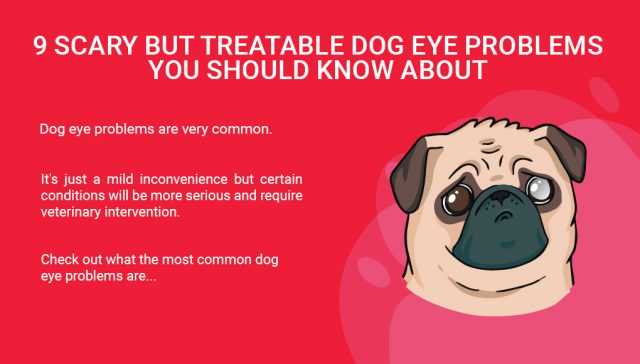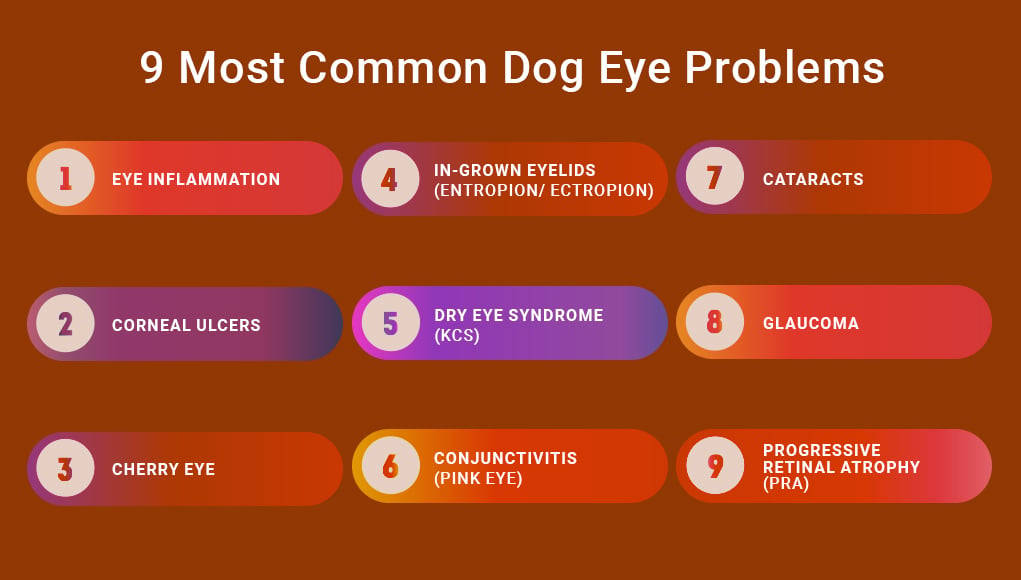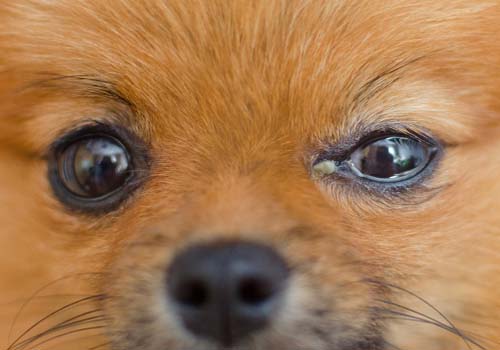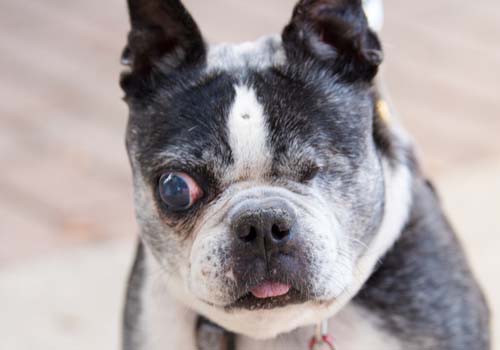
Table of Contents
- 9 Most Common Dog Eye Problems
- Signs that your Dog is Experiencing Vision Problems
- Can you use Human Eye Drops for your Dogs?
- How to Treat Dog Eye Infection
- FAQs
- Summary of Dog Eye Problems
A dog's vision is vital to helping them move around and make sense of the world. Problems that affect a dog's eyes happen at least once to most dog owners.
Although, in most cases, it's just a mild inconvenience.
However, specific eye infections in dogs will be more severe and will require veterinary intervention, including surgery.
Dry eyes, cataracts, corneal ulcers, progressive retinal atrophy, and glaucoma are dogs' most common eye conditions. It commonly occurs in breeds between 4 and 7 years old.

Eye disease is often inherited, and it's the most well-studied area of all inherited diseases in dogs.
Below is a list of the nine most common dog eye problems or dog eye infections that will include pictures, causes, prevention, and treatment.

9 Most Common Dog Eye Problems
1. Eye Inflammation
Eye inflammation in dogs is one of the leading dog eye problems, and it's usually a symptom of some underlying disease.
It is often a sign of infection in or near the eye. Still, it can also be due to allergies, autoimmune disease, and injury.
In rare cases, it can even be a sign of tumors. Some common symptoms of dog eye inflammation include redness, pain, discharge, and squinting.
Since a wide range of things can cause eye inflammation in dogs, it isn't easy to prevent it from occurring.
However, you can attempt to prevent these infections, particularly fungal and parasitic ones, by keeping your dog's living conditions sanitary.
The treatment will also depend on the underlying condition itself. Usually, it consists of ointments or eye drops to treat the inflammation.
Additionally, oral medications are often used to reduce the overall inflammation and pain in the dog's body.

2. Dog Eye Ulcer or Corneal Ulcers
Corneal ulcers are common but usually aren't as serious as they may sound. This is a surface erosion within the dog's eyes.
They usually occur after an injury by a foreign object. Still, they may also be caused by eyelashes, products, and clothing.
Even dog hair that scratched the dog's eye, inadequate tear production, or high intraocular pressure.
These ulcers are often not readily visible and look for any surface damage. If you notice that your pup keeps its eye closed or partially closed very often.
When you can't spot them yourself, take your dog to the vet for the proper diagnosis.
The thing you can do to prevent corneal ulcers is to keep your dog away from any possible eye trauma or injury.
This is especially true if you have a cat since cats can often cause these ulcers by scratching a dog's eye.
Corneal ulcers in dogs are treated with an antibiotic eye drop solution or topical ointments. Additionally, the topical medication for the pain (atropine, for example).
In some cases, you will also use systemic oral non-steroidal anti-inflammatory drugs (NSAIDs).
The vet may apply a soft contact lens and an Elizabethan cone for severe dog eye ulcers to keep the dog's eyes safe while they heal.
In this case, you should keep the dog indoors to avoid bright lights. Regular check-ups are also needed for severe corneal ulcers since the treatment can last for multiple weeks.

3. Cherry Eye (Third eyelid prolapse)
Dogs have a third eyelid, and the prolapse of that third eyelid is called cherry eye. The swollen mass characterizes this problem near the lower eyelid closest to the dog's nose.
Cherry eye is one of the most common dog eye problems, some pet owners notice. It usually occurs in puppies up to two years of age.
This illness is genetic, which is evident because certain breeds, like bulldogs, are at more risk than others. There isn't anything you can do to prevent it.
Smaller breeds and breeds with shorter muzzles are at a greater risk of suffering from the cherry eye.
The only safe way to get rid of cherry eyes in dogs for good is surgery. You can deal with this problem with a gentle eyelid massage with a warm cloth and eye drops.
This home treatment is only successful if the condition is diagnosed in the earliest stages. Even then, it may come back later.
Treating the cherry eye with a steroid ointment is another option, but not consistently effective.

4. In-Grown Eyelids (Entropion or Ectropion in Dogs)
Entropion in dogs causes the animal's eyelids to turn in. This results in pressing the eyelashes against the eye and can lead to dog eye ulcers.
And this can be very dangerous for your dog. Squinting, watery eyes, and keeping eyes closed are the most noticeable symptoms of ingrown eyelids in dogs.
Entropion is usually diagnosed very early in a pet's life, mainly before one year of age. Ectropion is a similar condition with a difference of outward rolling of eyelids instead of inward.
The treatment is the same as with entropion. Entropion or Ectropion is not preventable since it is usually a genetic condition.
Although some topical ointments and doggy eye drops can relieve the symptoms, the only long-term solution is a standard, low-risk surgical procedure to get rid of this for good.

5. Dry Eye Syndrome (KCS)
Dry eye syndrome, or Keratoconjunctivitis sicca (KCS), is the correct medical term. It is one of the more common dog eye problems in which the dog's tear glands don't produce enough tears.
That can lead to more severe complications, like corneal ulcers, pain, and chronic mucus drainage from the dog's eyes.
Autoimmune disorders mainly cause dry eye syndrome in dogs. Still, it can also be because of middle ear infection, trauma, damage to the facial nerve, or viral or bacterial eye infections.
It can also be a result of cherry eye surgery and the removal of the third eyelid. Some of the symptoms include red eyes, pain, squinting, and discharge of mucus.
There is no way to prevent dry eyes in dogs that's because of autoimmune disorders.
However, you can prevent other potential causes, like trauma to the eye or ear infection, by keeping the ear canals clean.
Most cases of dry dog eye are treated by topical medications, like artificial tear medication. A lubricant is also prescribed sometimes.
It is essential to keep your dog's eyes clean before you use any of the medicines.
Also, there have been advancements in treating dry eyes in dogs in recent years. Parotid duct transposition (PDT) surgery was shown in a 2009 study to have some great results.

6. Conjunctivitis (Pink Eye)
This is a name for inflammation of the conjunctiva, which are the mucous membranes that serve as a cover for a dog's eyelids. It's also one of the more common dog eye infections that pet owners quickly notice.
Pain and discomfort, swollen and reddened conjunctiva, and discharge are the usual symptoms of conjunctivitis in dogs.
Conjunctivitis is always a symptom of some underlying issue. Typically, one of the other mentioned dog eye problems above is dog eye infections, allergies, and inward-growing eyelashes.
A 2009 AVMA study shows that contact with other dogs is the most significant risk factor for contracting pink eye.
So, obviously, keep your dog away from other dogs that may have conjunctivitis.
Free-roaming dogs are most likely to contract viruses that cause this eye infection in dogs.
Also, some studies showed that neutering or spaying could help with prevention.
Treatment for pink eye in dogs will depend on the underlying cause.
You can use sterile saline eyewashes to clear the dog's eye and flush irritants for some essential treatment.
However, it is essential to get the correct diagnosis for the underlying cause. Take your dog to your vet to get the proper assessment and treatment for other dog eye infections.

7. Cataracts
Cataracts on dogs are the most well-known among dog eye problems.
A cataract is a name for a cloudy or opaque lens located in the center of the dog's eye, and it is usually clear. The cataract blocks light and prevents it from reaching the back of the eye.
For dogs with cataracts, this leads to poor vision or even blindness. The most crucial symptom of cataracts is white or grey pupils.
Cataracts can occur due to genetic reasons, but they can also occur because of diabetes, infection, or eye injury.
There is also a condition called lenticular sclerosis. It is similar to cataracts, but it is different and caused by aging.
Besides prevention in similar ways as other dog eye problems, nutritional deficiency can sometimes cause cataracts in dogs.
Making sure that your dog has a healthy and well-balanced nutritional diet is essential. Regular vet check-ups are necessary for early detection and for any other eye infections in dogs.
How much does it cost to remove Dog Cataracts?
Treating the underlying cause of cataracts is the first treatment option when that is possible. Surgical removal of cataracts is often the way to go if the dog is otherwise healthy.
However, you can only recommend surgery if the dog's vision is severe. In minor cases, dogs can get used to dealing with poor eyesight.
In general, cataract surgery for dogs costs between $2700 and $4000, and the average price is $3700. This already includes the exam, hospitalization, medications, and other surgery essentials.

8. Glaucoma
Glaucoma is a condition that disrupts the balance of production and drainage of fluid in the eyes and increases eye pressure.
Pain, increased tear production, eye redness, corneal cloudiness, and dilated pupils are the most common symptoms of glaucoma.
In severe cases, the eye will become enlarged. Primary glaucoma is genetic, while secondary glaucoma can be because of infection or injury.
It's one of the most severe dog eye problems, and if left untreated, can lead to blindness.
Providing your dog with enough antioxidants can promote the dog's general eye health and decrease damage in case of an injury or eye infection in dogs.
Avoid tight collars since studies show they can increase intraocular pressure. Get regular eye examinations for early detection.
In severe cases of glaucoma in dogs, surgery is often the best and only option.
Otherwise, glaucoma is usually treated by a mix of topical and oral medications, similar to other dog eye problems.

9. Progressive Retinal Atrophy (PRA)
Progressive Retinal Atrophy (PRA) is a severe eye condition in dogs that gradually leads to blindness.
The lack of symptoms, until the condition becomes obvious, makes it one of the hardest to spot dog eye problems.
Usually, the first symptom of PRA in dogs is night blindness, and after that comes poor overall vision.
If you notice that your pup is often tripping over things, bumping into furniture or walls, and generally displays signs of poor vision, PRA could be the culprit.
Progressive retinal atrophy in dogs is a genetic disorder, and there is no way to prevent it. One of them is responsible for breeding and or neutering dogs at the right age.
Since in some breeds, dogs that got the gene from only one parent won't develop the condition.
At the moment, there is no effective treatment available for PRA in dogs.
Management of the condition is the only available option for pet owners. The disease itself is painless, so dogs usually adapt well to going blind.
Most of these typical dog eye problems mentioned above are easily treatable. However, early detection and proper diagnosis are critical.
Take your dog to the vet for regular check-ups or as soon as you notice some of the symptoms of eye problems.
Do your own check-ups of your pup's eyes when grooming or after injuries and accidents.

Signs that your Dog is Experiencing Vision Problems
Each disease has its different symptoms, but here are some signs to look for when you feel like your dog is experiencing problems.
- Bumping into appliances or objects
- Cloudy Eyes
- Anxiety or hesitation in new places
- Inflamed Eyes
- Eye Irritation
- Easily Startled
When to go to the Vet
Furthermore, calling or going to your vet is still the best option for any health concern for your pup. Don't just rely on comment sections and self-diagnose your dog.
If your dog is constantly scratching their eyes and it appears swollen or reddish, it's a great time to consult your vet. From this, your vet can recommend a proper veterinary ophthalmologist if needed.
Can you use Human Eye Drops for your Dogs?
You should never use human eye drops for dogs. Always consult with your vet before using or even buying these for your pup.
Not all ingredients in human eye drops are suitable for dogs. Some of the ingredients can cause low blood pressure and can significantly drop their heart rate.
For instance, an eye drop for redness has an ingredient called naphazoline that can be harmful to your dogs. Moreover, other glaucoma eye drops have ingredients called brimonidine that can be poisonous to your pup.
How to Treat Dog Eye Infection
The first thing you should do is call or go to your vet to get your dog examined and to get the proper treatment for dog eye infections. Your vet will be the one to tell you what antibiotic the dog needs or, in some cases, surgery.
If the dog's eye infection is deeper within the eye, antibiotics or other injected medications might be needed. Moreover, there are still some other techniques you can do to help your dog calm and relieve in your home.
Firstly, make sure that your dog's eye is clean. Gently wipe the area with a clean cloth with warm water. This can improve the healing process of eye infections in dogs.
Your goal is to remove the discharge and not hit their eyeballs. Do not use any chemicals or makeup removal items.
Another technique is using the cone. Your vet may already prescribe this, as it can help the treatment work completely.
The cone lessens the chance of your dog scratching or doing further damage to the dog's eye infection.
FAQs
How much does it cost to remove dog cataracts?
Cataract surgery today can cost between $2700 and $4000 USD. Fortunately, getting pet insurance should help with covering this cost.
How can I treat my dog's eye infection at home?
There really isn't much you can do except try using saline solution eye drops or a saline eye wash.
To make and apply the eye wash, check out this article on treating dog eye infections at home.
This will flush out anything that is irritating your dog's eyes.
However, it won't solve the problem other than providing temporary relief. You will most likely need to take your dog to get checked by a vet for the next steps.
Summary of Dog Eye Problems
For those still wondering about the health of their dog's eyes, several issues can cause dog eye problems.
Dog owners should know when to bring their dog to the vet for an allergic reaction or dog eye infection. In the case of minor problems, you can try a sterile saline rinse.
However, in most cases, your dog will need further treatment, so you should visit the vet.
After an in-person visit, your veterinary ophthalmologists have the equipment to find the proper treatment for your dog's eye problems.
They will want to examine your dog's head as well as your dog's cornea and maybe their tear-producing gland.
It is easier to notice signs of eye infection in dogs if you know what to look for.
Common signs include light sensitivity, blinking, redness, swelling, squinting, pawing at the eye, and a thick smell or watery discharge.
READ NEXT: 7 Most Serious Eye Problems in Dogs and How to Deal With Them












